
About Andrew Cusack
 Writer, web designer, etc.; born in New York; educated in Argentina, Scotland, and South Africa; now based in London.
Writer, web designer, etc.; born in New York; educated in Argentina, Scotland, and South Africa; now based in London. read more
News
Blogs
Reviews & Periodicals
Arts & Design
World
France
Mitteleuropa
Knickerbockers
Argentina
The Levant
Africa
Cape of Good Hope
Netherlands
Scandinavia
Québec
India
Muscovy
Germany
Academica
Paul Comtois of Québec
Farmer, Politician, Hero, Saint

FROM TIME TO TIME there are men in history whose heroism runs so counter to the spirit of the age that the arbiters of passing fashion must simply ignore him rather than run the risk of acknowledging his embarrassing greatness and goodness. God has graced the New World with many of His saints, some of whom — Rose of Lima, Martin de Porres, Mother Seton — have already been raised to the altar, others — Fulton Sheen, Fr. Solanus Casey — are certainly on their way. Yet more remain unsung and almost forgotten: Paul Comtois (1895–1966), Lieutenant-Governor of Québec until his heroic death, is just one of these saints.

The province of Québec
Jean-Paul-François Comtois was born in Saint-Thomas-de-Pierreville, in Québec’s Yamaska County on 22 August 1895. His father, Urbain Comtois, was a merchant of old Québécois farming stock while his mother, Elizabeth (née McCaffrey) was of Irish descent.
After completing the cours classique at the Collège de Nicolet, Paul Comtois was admitted to the Université de Montréal. He studied agronomy at the Institut agricole d’Oka, an agricultural institute run by monks at a Trappist monastery, and received his degree in 1918.
His studies completed, Comtois returned to Pierreville to run the family farm, Ferme des Ormes, whose land had first been cleared by his grandfather in 1835. In 1921, he married Irène-Anne-Rachel Gill, who provided Comtois with three sons and two daughters.
Paul Comtois continued to farm for two decades, earning the médaille de bronze du Mérite agricole in 1926, but also became an increasingly active participant in the civic affairs of his community. He was made the head of the local school board in 1928, and ran as the Conservative candidate for the the Nicolet-Yamaska constituency in the 1930 federal parliamentary election — losing by just one vote!
Comtois was chief evaluator for the Agricultural Commission from 1935 to 1936 when he became the general manager of the provincial Office du crédit agricole, a post he held until 1957. In the mean time, he served for a year on the Housing Committee, co-founded the agricultural cooperative in his native Pierreville, and was made president (from 1945 to 1961) of the Caisse populaire de Pierreville, one of the cooperative credit unions founded by the Church to provide for the financial well-being of people in rural Québec.
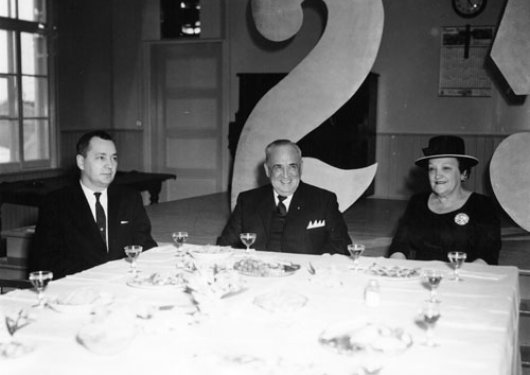
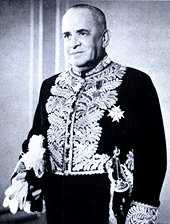 L’hon. Paul Comtois, Lieutenant-gouverneur du Québec
L’hon. Paul Comtois, Lieutenant-gouverneur du QuébecPaul Comtois was mayor of Saint-Thomas-de-Pierreville from 1948 to 1961 and was made Prefect of Yamaska county in 1956. A year later, he avenged his 1930 electoral defeat by winning election to the House of Commons for Nicolet-Yamaska in the 1957 election.
That August, Prime Minister John Diefenbaker made Comtois Minister of Mines in his cabinet and he was appointed to the Privy Council. After four years in the Canadian cabinet, the Governor-General, on the advice of the Prime Minister, appointed Paul Comtois as Lieutenant-Governor of Québec, personal representative of H.M. the Queen in the province.
Comtois took to the viceregal office with ease. A popular socialite, he was a member of the Garrison Club and the Quebec Winter Club. A devoted Catholic, he was active in the Knights of Columbus and the League of the Sacred Heart. As is custom for Canadian viceregal representatives, Comtois was made a knight of the Venerable Order of St. John.
He received an honorary doctorate from the University of Sherbrooke in 1962, and another from McGill University a year later, and was made Commander of the Ordre du mérite agronomique.
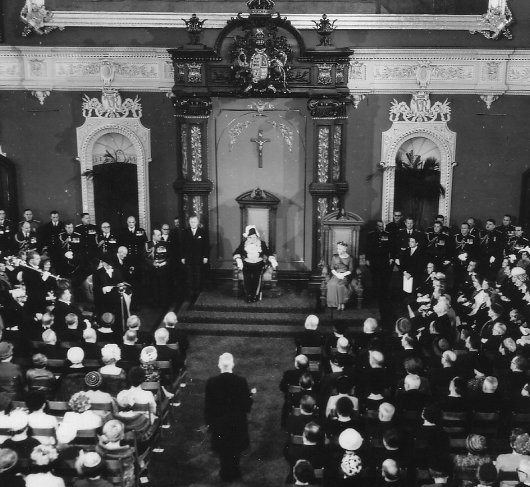
Lieutenant-Governor Paul Comtois opening the annual session of the Parliament of Québec.
Yet while the Lieutenant-Governor and his wife attended balls at the province’s best hotels and were invited to dinner parties in its most prominent homes, the entire family said the Rosary together every day, often outdoors despite the harsh winter cold.
The family lived in the official viceregal residence, Bois-de-Coulonge, in the Quebec City suburb of Sillery (a city named after the holy Frenchman Noël Brûlart de Sillery). Comtois sought permission from the Cardinal Archbishop of Québec, Primate of Canada, to reserve the Blessed Sacrament in the private chapel at Bois-de-Coulonge. The Cardinal was hesitant but eventually agreed to Comtois’s pious request.
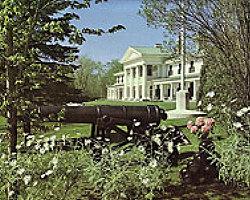
Bois-de-Coulonge
“My father once told me that he had difficulty in being granted the special permission from the Cardinal to permanently keep the Blessed Sacrament in the private chapel,” Comtois’s daughter Mireille recalled later.
“When he finally was given this permission, it was on condition that he be personally responsible for its safe and proper keeping. And my father was a man who lived up to his obligations at all costs.”
After midnight on the evening of February 21, 1966 — a bitterly cold night of -24° F (-31° C) — the Lieutenant-Governor, his family, and some guests returned to Bois-de-Coulonge from an event. Half an hour after the assembled had said their goodnights and retired to bed, a ferocious fire erupted in the basement of the 105-year-old manor.
“The fire started as though it were in a matchbox,” Lt. Col. J.P. Martin, the Lieutenant-Governor’s aide-de-camp, reported. “It was incredible to see with what speed the flames spread through the building.”
As soon as the fire was noticed, the governor immediately took charge, guiding his wife and children out of the house into the cold winter’s night outside. His daughter Mireille, however, noticed her father would not yet leave the tinderbox house.
“As I was racing through the building to escape from the fire, I came upon my father in the chapel. As I was going to run to him, he firmly ordered me to jump from a nearby window and I did, wondering why he did not do likewise. The last I saw of him, he was standing under the sanctuary lamp in his pajamas and wearing around his neck the souvenir Rosary from his father which he said every night and wore to sleep.”
Having been assured that all his family and guests had escaped the inferno, the seventy-year-old Paul Comtois returned to the private chapel in which he visited the Lord every evening before bed to save the Blessed Sacrament from the desecrating fire. He reached the chapel, already engulfed in flames, but managed to make it to the tabernacle and remove the pyx containing the Body of Christ.
Leaving the chapel, he descended the staircase which collapsed about him, and the Lieutenant-Governor was burned alive in the inferno. The fire in which Paul Comtois died was so hot that the first firemen on the scene could not approach within a hundred feet of the building.
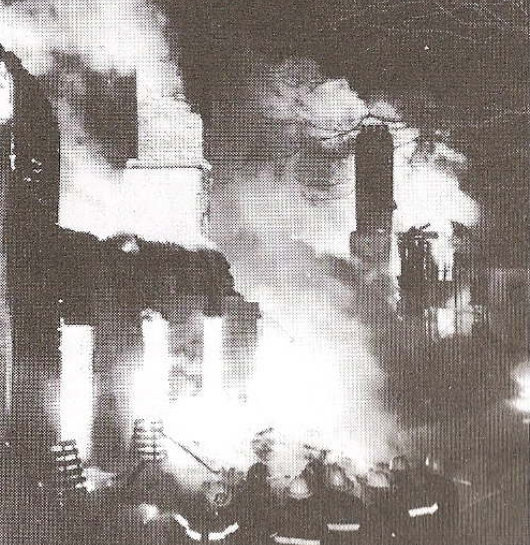
“I was told,” Mireille continues, “that when they found him, his body was badly burned and his arms were no longer intact; but my father was a big stocky man and under the upper part of his body they found the pyx used to carry the Holy Eucharist. His body had saved it from the flames. … I can still picture him standing there in the light of the sanctuary lamp.”
Maurice Cardinal Roy, the Archbishop of Québec & Primate of Canada, said that “Mr. Comtois, as a Christian, gave an example of wisdom and goodness, humility, and radiant faith.”
Mac Stearns was one of the family’s guests that evening. “I jumped to safety from a second-storey balcony, injuring my back in doing so and was hospitalized for some time after,” he said.
“My wife and I were good friends of the Comtois family,” Stearns continued. “We were in the habit of visiting one another. I grew to be a close friend and admirer of Paul Comtois. He was a very sincere person, deeply concerned with the problems of humanity.”
“His tremendous religious faith impressed me greatly and was no doubt instrumental in my embracing the Catholic faith some time after his death. Knowing his great fervor for the Blessed Sacrament, I have no doubt whatsoever that Paul would do all in his power to rescue the Holy Eucharist from the fire.”
Paul Comtois’s heroism stands in direct contrast to the cowardice of the changing establishment of the time in reporting his death.
“The left-wing press: Le Devoir, La Presse of Montreal, Le Soleil of Quebec City, played down the wonderful deed,” wrote Fr. J. M. Laplante, O.M.I. in The Wanderer (10 March 1966). “In other times, that news would have covered the world with headlines. But nowadays? I doubt if La Croix and Les Informations Catholiques Internationales of Paris, or the liberal Catholic weeklies, will give much coverage or comment to that sublime act of faith.”
“But what an act of reparation,” Fr. Laplante wrote, for the errant priests who do not believe in the Holy Eucharist and desecrate the Blessed Sacrament themselves.
“The fact that, in 1966, a politician, a statesman, the Anglican Queen’s immediate representative in Québec, imitated the gesture of St. Tarcisius should be shouted from the rooftops. … Yes, His Excellency Paul Comtois, host of Christ in Bois-de-Coulonge Manor, gave up his life for the sake of Christ the Host!”
Sister Maureen Peckham, R.S.C.J., wrote in 1988 of the Lieutenant-Governor’s heroic death in her introduction to John Cotter’s The Affirmation of Paul Comtois:
“Over twenty years have passed since, in an act of gallant generosity, a supernaturally splendid ‘beau geste’, Paul Comtois, Lieutenant-Governor of the Province of Québec, laid down his life for his Friend in the Blessed Sacrament. His story, far from making the headlines, was considered, by the secular press, not newsworthy, and, by the Catholic press, an embarrassment. The Church of the second half of the twentieth century is, to its shame, not noted for its faith in the Blessed Sacrament, and, one can only deduce that it was fear of being considered foolish and old-womanish — or, worse still, old hat — by an unbelieving world that caused the leaders of the Church in Québec to pass over, in blushing silence, Mr. Comtois’s noble deed.”
“Yet, Paul Comtois was a man of the world, a well-known socialite, one who had reached the heights of worldly glory; he was one whom the world could recognize as its own. Furthermore, his chivalrous and brave death should, even on the human and wordly level, have merited the title of hero. That he, who had been honored by the world during his lifetime, should have been ignored by the world at the moment of his death, can only be explained by the fact that he died for One Whom the world does not recognize and has ever refused to acknowledge.”
“The glorious martyrdom of Paul Comtois, passed over as it was by an unbelieving world, and by an all too unbelieving Church, has, nonetheless, remained in the faithful memory of God’s true friends. That one of these should today be putting into print Mr. Comtois’s shining witness of charity, in its radical and essential loveliness, is indeed a welcome and joyous event. May this inspiring story enflame the hearts of all who read it with an undying love for the Lord of the Tabernacle.”
Paul Comtois, priez pour nous !
Search
Instagram: @andcusack
Click here for my Instagram photos.Most Recent Posts
- Sag Harbor Cinema March 26, 2025
- Teutonic Takeover March 10, 2025
- Katalin Bánffy-Jelen, R.I.P. March 3, 2025
- Substack Cusackiensis March 3, 2025
- In the Courts of the Lord February 13, 2025
Most Recent Comments
Book Wishlist
Monthly Archives
Categories



Bld. Paul Comtois,
ORA PRO NOBIS!!!
It was a period in Canadian and Quebecois, history in which the vice-regal offices were held by saintly Roman Catholics. Paul Comptois’ life in many ways was similar to that of Georges Vanier, Governor General of Canada from 1959 to 1967. A decorated officer in Canadian Forces and then an accomplished diplomat, Vanier was a devout and pious Catholic as well as “a man the world could recognize as its own”. In Canada, many Catholics would like to see his name brought forth to the Congregation for the Cause of Saints.
Great article Andrew. Keep up the good work.
IM
I had never heard of Paul Comtois of Québec; until I read this article. What a great man!
Thanks for reminding us that saintly people exist in every age.
Also, many thanks to John Zmirak who mentioned Mr. Cusack’s article at Takimag.
http://www.takimag.com/sniperstower/article/a_frenchman_for_all_seasons/
EP
What an amazing story! I had never heard about this before! Amazing that his cause for beatification and canonization has never been opened… yet! I pray this becomes well known. Thank you, Mr. Cusack, for another great article.
How inspiring this is. He has set the example. May we all, especially Catholics, learn to truly acknowledge, respect, and adore God’s presence in the MOST HOLY EUCHARIST.
Too much indifference towards the Eucharist is shown nowadays in the churches. May the Lord open our eyes so that we may learn to keep Holy Silence in church ALL the time.
Praised be Christ the King.
Splendid post. The comment about George Vanier is also welcome, and would be worth a similar tribute.
How embarrasing those “Catholics” seem who can’t even refrain from Our Lord in the Eucharist when they dissent.
Such an act committed but two centuries or so ago would have been endearingly lisped by children, sung by troubadours, and mellifluously trumpeted by every priest in every parish of the Catholic world!
What a pitiful, slavishly grovelling age of Catholics this is! Not only are many of us incapable of such love and valour, but we dare not even praise it.
May the saint and martyr that this great soul is procure for us the grace that inspired him!
An article on General Vanier has been in preparation for quite some time now.
I had the privilege during my recent visit to Québec to visit the tomb of the holy general in the Citadelle and pay my respects there. A splendid and much appreciated blessing.
Nearly brought tears to my eyes. My biggest wish (one of them) in life is to somehow get to a point where I a) have the means to build a private home chapel b) get my spiritual life to a point where a cardinal or bishop entrusts me with keeping the Eucharist there c) die in the defense of our Lord. My wife and I built a little one in our tiny townhome, here in MD. By an act of grace, Uncle Norman (God rest his soul) got a 1st class relic of St. Pius X, and it got passed onto my stewardship. Ironically, he lived up in New Rochelle, NJ. There is an awesome feeling of gratitude that comes with a privelege like that. The only danger I can see is that the world sometimes consumes you, and you start to take it for granted. I would never want that to happen with the Lord, so maybe it’s better for me to keep the longing to meet Him at Adoration or Mass. As far as dying in fedense of the Lord, if America keeps slipping away and Catholics become more apathetic (is that possible?), I might just be granted my heart’s desire! ;)
Either way, I’m gonna ask Paul Comtios to pray for my family!! Awesome, awesome write up. Just found this blog, and glad I did!
andrew,
Thanks so much for bringing this inspiring story to our attention. I often get the chance to visit Quebec. The current ideology there has nothing but hatred for the infamous Catholic days of yore…..
What a beautiful and inspiring story. We need him as a saint. We need the reminder of the place the Holy Eucharist should hold in each of our hearts and souls. Many thanks for this story and many more thanks to the person who forwarded it to me.
Andrew, remarkable piece!
Many many thanks. I’ve aded him to my “heros” and am now praying to him to ask his intercession.
But what can we do to begin his cause of Sainthood?
I’d never heard of this martyr either. Neither of the histories of modern Canada which I’ve read mentions him (or any other vice-regal Quebecker) at all. So congratulations and thanks to Andrew Cusack.
Thanks for post. The residence was originally called Spencerwood. They changed it to a French name after the fire. It’s a beautifully kept park now. There is no official residence of the Lt. Gov now, s/he resides in a suite in the Chateau Frontenac Hotel when s/he is in Quebec City.
The last photo shows Comtois’ immediate predecessor, the Hon. Onésime Gagnon, PC QC LLD, Rhodes scholar, who was Minister of Finance of Québec when appointed Vice-Roy in 1958.
Spencer Wood became Bois-de-Coulonge in 1950, 16 years before the fire. Duplessis, the Quebec Prime Minister, had just given the Province its present flag, the fleur-de-lysé.
Andrew,I first read the story of Paul Comtois around twenty years ago and have used it many times to instruct my children on the glorious aspects of our Catholic Faith.To read the story again just now was a thrilling reminder of the heights of heroism that men can be called to in the love and service of their God.
Paul Comtois…..”well done ,good and faithful servant….”
I believe that my grandmother, Eva Comtois Dorval was the first cousin of Paul Comtois. I think that her father and Paul Comtois’ father were brothers. At the time of the fire, my grandmother had received a copy of a Sunday newspaper,(long since lost). The Andrew Cusack article brings back memories of that paper. My grandmother had two sisters who were nuns. One was Mary, who died while working among the lepers in China. A book has been written about her. Another sister, Aline, died in Lachine at the mother house of the Sisters of St. Anne. It appears that this was a very pious, and in the case of Mary, saintly family. I am looking for more information about the history of this family. The history of Aunt Mary’s work in China was documented by a priest. I sincerely hope there is someone who can help me with this search. Thank you. Philip Jacques Gardner, Massachusetts 01440.
The previous note is from my brother, Philip Jacques. I wonder if you could please tell us the names of Paul’s children. My mother and father had visited him right before I was born and my middle name, Audette, was apparently given to me after one of his daughters. Would be interesting to find out more about his family.
Thank you!
Dear Sir:
I have a copy 0f the death notice dated 1966 among my family papers. My maternal grandmother, Elise Dauplaise,
was born in Detroit, but her parents Pascal and Lea
Duplaise were born in Canada. I have been unable to establish any family connection thus far. Perhaps, his
children may have heard of the family.
Thank you for marking the life of a remarkable Christian, who was truly overlooked during his lifetime
Best regards,
Elise Claire Dillman Richardson
I’m delighted to read this article, especially as I researched the story myself here in Ireland some years ago, and published my work in CATHOLIC LIFE magazine (Manchester UK)
I re-lived the whole experienc, reading your article. Thanks.
This was just passed around via Facebook and what a wonderful article. Thank you for sharing this. What a Christian life he led!
thanks for posting this. awesome to have something one of my ancestors did